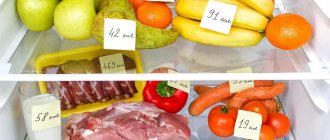Human energy consumption. Energy consumption standards for adults
The quantitative side of nutrition is determined by the energy that is released from food substances in the process of biological oxidation and is expressed in kilocalories.
The equivalents of available energy released during the breakdown of the digestible part of food are the following values: 1 gram of protein - 4.0 kcal., 1 gram of fat - 9.0 kcal., 1 gram of carbohydrates -4.0 kcal., 1 gram of alcohol - 7 .0 kcal., 1 gram of organic acids - 3.0 kcal.
The daily energy requirement is related to the body's energy expenditure. A person’s energy consumption depends on physical activity, gender and age. In accordance with the size of energy consumption, 5 groups of the working population are distinguished. The division into groups is partially based on certain professions. Gradation into groups is carried out according to the value of the basal metabolic rate, taking into account the coefficient of physical activity.
The basal metabolic rate is the minimum amount of energy required to carry out life processes, that is, energy expenditure for the performance of all physiological, biochemical processes, for the functioning of organs and systems of the body in a state of temperature comfort (20 ° C), complete physical and mental rest on an empty stomach. The basal metabolic rate reflects the energy expended by the body on metabolic processes, maintaining blood flow and respiration at rest.
For a person of a certain gender, age and body weight, the basal metabolic rate has a constant rate. In this case, a person’s height does not play a special role.
Basic metabolic values for an adult (kcal/day):
| Body weight in kg | AGE (years) | |||
| 18-29 | 30-39 | 40-59 | Over 60 years old | |
| MEN (energy expenditure in kcalories) | ||||
| 50 | 1450 | 1370 | 1280 | 1180 |
| 55 | 1520 | 1430 | 1350 | 1240 |
| 60 | 1590 | 1500 | 1410 | 1300 |
| 65 | 1670 | 1570 | 1480 | 1360 |
| 70 | 1750 | 1650 | 1550 | 1430 |
| 75 | 1830 | 1720 | 1620 | 1500 |
| 80 | 1920 | 1810 | 1700 | 1570 |
| 85 | 2010 | 1900 | 1780 | 1640 |
| 90 | 2010 | 1990 | 1870 | 1720 |
| WOMEN (Energy expenditure in kcalories) | ||||
| 40 | 1080 | 1050 | 1020 | 960 |
| 45 | 1150 | 1120 | 1080 | 1030 |
| 50 | 1230 | 1190 | 1160 | 1110 |
| 55 | 1300 | 1260 | 1220 | 1160 |
| 60 | 1380 | 1340 | 1300 | 1230 |
| 65 | 1450 | 1410 | 1370 | 1290 |
| 70 | 1530 | 1490 | 1440 | 1360 |
| 75 | 1600 | 1550 | 1510 | 1430 |
| 80 | 1680 | 1630 | 1580 | 1500 |
The ratio of energy consumption to the basal metabolic rate is defined as the coefficient of physical activity and is:
for group 1 - 1.4 (managers of enterprises, engineering and technical workers, doctors, teachers, educators, secretaries, scientists, dispatchers, control panel workers, etc.);
for the 2nd group - 1.6 (workers employed on automated lines, in the radio-electronic industry, agricultural specialists, nurses, orderlies, sellers of manufactured goods, communications workers, service workers, urban public transport drivers, garment workers, trainers, etc.);
for the 3rd group - 1.9 (machine operators, mechanics, surgeons, chemists, drivers of excavators, bulldozers, railway workers, textile workers, drillers, metallurgists, blast furnace workers, food industry workers, public catering workers, food sellers, etc.);
for the 4th group - 2.2 (builders, agricultural workers and machine operators, oil and gas industry workers, metallurgists, foundry workers, etc.);
for the 5th group - 2.5 (miners, steelworkers, masons, fellers, diggers, loaders, reindeer herders, etc.)
In order to calculate a person’s daily energy expenditure, the basal metabolic rate must be multiplied by the physical activity coefficient.
How to calculate your daily energy consumption
Example: You are a 35-year-old woman, your weight is 58 kg, and you are an accountant by profession. In the first table we find the column 30-39 years and the line 55 kg (2 kg is missing from 60, so you need to take the lower number), so your basal metabolic rate is 1260 kcal/day. The accountant profession most satisfies the first group, which means your physical activity coefficient will be 1.4.
We calculate daily energy consumption: 1260 ¤ 1.4 = 1764 kcal/day
In addition to dividing the population by energy consumption, each of the five groups is divided into three categories by age.
Men, especially young men, have the highest needs for energy and basic nutrients.
For pregnant and lactating women, an addition to the norm of the corresponding group of women is provided due to the additional need for energy and nutrients.
For persons engaged in active forms of recreation and living in areas with less developed public services, additions to the energy requirements are not provided.
Energy exchange. Determination of daily energy consumption
And nutritional needs
Various population groups
Target
— to develop students’ skills in determining the daily energy consumption of various population groups and their needs for nutrients and energy.
Educational
determine your own daily energy costs and consumption
exercise:
content in nutrients.
Guidelines Determination of energy consumption
A person's energy requirement determines the level of energy consumed from food, which should balance energy expenditure, maintain a stable state of health and ensure the maintenance of desired physical activity.
The energy requirement of children, pregnant and lactating women also includes additional needs associated with the formation of tissue or milk at a level that ensures normal life activities.
In general, daily energy expenditure consists of energy expenditure for basal metabolism, metabolic response to food intake (specific dynamic action of food - SDDP) and physical activity.
Energy consumption can be determined by various methods;
1) by direct calorimetry method.
The method is based on determining the amount of heat released by the body into a coolant (most often water) circulating in special chambers with
double walls (Shaternikov, Pashutin, Atwater-Benedict chambers, etc.);
2) by the method of indirect calorimetry (gasometric).
The method is based on determining the chemical composition of inhaled and exhaled air with the subsequent establishment of the respiratory coefficient. Based on the value of the respiratory coefficient, the energy equivalent of one liter of absorbed oxygen is determined and the energy consumption for the work performed or basal metabolism is calculated. The determination is made using different types of gas analyzers;
3) time-table method.
Using this method, the daily time budget is first timed; a chronogram of the day is compiled, and then, using tables and physical activity coefficients (PFA), energy consumption is calculated for individual types of activities and for the day as a whole;
4) nomographic method.
The amount of energy consumption and compliance with their needs can be determined using nomograms or nomographs.
In addition, there are nomographic rulers for calculating ideal weight taking into account height, chest circumference and gender. If you have an ideal weight, it is considered that the caloric content of the diet is adequate to the amount of daily energy expenditure.
The deviation of your actual weight from your ideal weight should not exceed 15%.
58
59
The nomogram of energy requirements and the determinant of the needs of various population groups for nutrients and energy according to the standards of the USSR Ministry of Health (1991) are widely used.
Nomographic methods for determining the caloric content of food consumed or necessary to satisfy the physiological need for energy are, like previous methods, indirect. With their help, the amount of energy consumption is determined approximately. More accurate calculation methods for determining energy consumption include the so-called chronometric methods, based on an accurate accounting of all types of human activities, their duration, as well as the value of the basal metabolic rate, gender, and age of the person.
Determination of the basal metabolic rate
The most important component of energy expenditure is the basal metabolic rate, which can be accurately measured under standardized conditions and used as a multiple to calculate all components of total energy expenditure.
Direct determination of BOO requires the creation of artificial conditions for the subject (measurement should be carried out no earlier than 14 hours after eating, with complete physical and mental rest of the subject, in a supine position, in conditions of thermal comfort).
BOO depends mainly on a person's body weight and age. BOO per unit mass changes with age (it is higher in children and lower in the elderly) and also with body weight (within any age range it will be higher in short and thin people and lower in tall and obese people). Based on this, the following formulas are proposed for calculating BOO (Tables 7, 8).
Table 7 Formulas for calculating BOO based on weight , height and gender1
| Age range (years) | Men | Zhsnshiny |
| 10-18 | 16.6MT' + 77P + 572 | 7.4MT + 482R + 217 |
| 19-30 | 15.4MT-27R + 717 | 13,ZMT + 334R + 35 |
| 31-60 | IUMT+16P+901 | 8.7MT-25R + 865 |
| >60 | 8.8 MT+ 1128 R- 1071 | 9.2MT + 637R-302 |
Table Formulas for calculating BOO based on body weight and gender
| Age range (years) | Men | Women |
| 10-18 | 17.5 MT+ 651 | 12.2MT + 746 |
| 19-30 | 15.3 MT +679 | 14.7 MT + 496 |
| 31-60 | I.bMT + 879 | 8.7 MT + 829 |
| >60 | 13.5MT + 487 | 10.5 MT+596 |
BOO can also be determined from the data given in table. 9 (for men) and in table. 10 (for women).
Table 9
Basal metabolic rate for men depending on body weight and age, kcal
| MT, kg | 18-29 years old | 30-39 years old | 40-59 years old | 60-74 years |
| 50 | 1 450 | 1370 | 1280 | 1 180 |
| 55 | 1 520 | 1430 | 1350 | 1 240 |
| 60 | 1 590 | 1500 | 1410 | 1300 |
| 65 | 1 670 | 1570 | 1480 | 1 360 |
| 70 | 1750 | 1650 | 1550 | 1 430 |
| 75 | 1 830 | 1 720 | 1620 | 1 500 |
| 80 | 1 920 | 1810 | I 700 | 1 570 |
| 85 | 2 010 | 1 900 | 1780 | 1640 |
| 90 | 2 110 | 1 990 | 1 870 | 1720 |
Table 10
Basal metabolic rate for women depending on body weight and age, kcal
| MT, kg | 18-29 years old | 30-39 years old | 40-59 jrc-i | 60-74 years | |
| 40 | 090 | 1 050 | 1020 | 960 | |
| 45 | 150 | 1 120 | 1 080 | 1030 | |
| 50 | 230 | 1 190 | I 160 | 1 100 | |
| 55 | 300 | 1260 | 1220 | 1 160 | |
| 60 | 380 | 1340 | 1300 | 1 230 | |
| 65 | 450 | 1410 | 1370 | 1290 | |
| 70 | 530 | 1490 | 1440 | 1360 | |
| 75 | 600 | 1550 | 1410 | 1430 | |
| 80 | 680 | 1630 | 1580 | 1 500 | |
Notes:
1Regulated by WHO.
2MT - body weight, kg; R—height, m.
Height
measured with an easel wooden stadiometer as follows. The subject stands on the stadiometer platform with his back to the stand with the scale and touches it with three points: heels, buttocks and the interscapular part of the body. The head should not touch the stadiometer, but should be slightly tilted so that the upper edge of the auditory
60
61
the passage and the lower edge of the orbit were located on the same line, parallel to the floor. The measurer stands on the side of the person being examined and lowers a bar sliding along a centimeter scale onto his head. The count is made at the lower level of the bar.
Body mass
determined by weighing on a medical scale. The subject stands in the middle of the scale platform. Determination of body weight should be carried out on an empty stomach, after emptying the bladder and bowels, without clothing. If it is impossible to weigh without clothing, then its approximate weight is subtracted from the total weight.
To determine BOO per minute, the indicators are divided by the number of minutes in a day, i.e. by 1,440 minutes.
The second component of daily energy expenditure is the specifically dynamic effect of food
(SDCP), i.e. metabolic reaction to food intake, characterized by the intensity of metabolism after eating and depends on its composition. When consuming predominantly carbohydrate foods, the metabolic rate increases by 4-7% of the basal metabolism, fatty foods - by 4-17% and protein foods - by 30-40% BOO. The average value of SDDP with a mixed diet is 10-15% of the basal metabolism.
The third component of daily energy expenditure is energy expenditure associated with physical activity.
According to WHO recommendations, the physical activity quotient (PFA) can serve as a criterion for physiological activity during various types of activities. O is defined as the quotient of total daily energy expenditure for all types of activity divided by the value of basal metabolic rate. Thus, CFA with energy consumption of 3.24 kcal/min and BOO = 1.08 kcal/min will be 3.84: 1.08 = 3.
Energy consumption for physical activity is determined by:
a) professional activity, depending on the nature of the profession, the length of the working day;
b) activity during non-working hours (housekeeping, gardening, home repairs and improvements, etc.);
c) socially desirable activity (attendance at public meetings, participation in sporting events or festivals, physical education and sports).
The structure of the daily time budget and the amount of daily energy consumption are characterized by the timing of activities (on duty and during non-working hours), i.e. a list of all types of activities and their duration. Since the same types of activities can be repeated during the day (eating, walking, traveling in transport, etc.), these types of activities can be combined. To determine the energy consumption
62
spending per day, you need to create a chronogram, i.e. list the weight of activities and their duration per day (taking into account the CFA for each). The chronogram and results of determining daily energy consumption are presented in the form of tables (Tables 11, 12).
Table 11
Chronogram example
| Type of deyagelnoeti | Period | Duration, min |
| Dream | 24.00-6.00 | 360 |
| Bed cleaning, toilet | 6.00-6.10 | 10 |
| Eating | 6.10-6.25 | 15 |
| Walk at a normal pace until the Granenort stop | 6.25-6.35 | 10 |
| Help in transport | 6.35-7.00 | 25 |
| etc. until 24.00 | 1440 |
Table 12
Daily energy consumption
| Gender - male; age - 40 years; body weight - 70 kg; height - 170 cm; BOO per day - 1,884 kcal; BOO per minute - 1.30 | ||
| Kind of activity | CFA * BOO/min * Time (min) | kcal/day |
| Sleep Toilet, cleaning Eating… | 1 * 1.30>=360 1.8 x 1.30×10 1.7 x 1.30×60 | 468 23,4 132.6 |
| Total | ||
Note.
Taking into account the possible deviation from the average daily time budget, as well as energy costs for the SDDP, the resulting value of daily energy costs should be increased by 10%.
The most typical types of activities and KFA are given in table. 13 (for men) and table. 14 (for women).
63
Table 1 3
Table 14
Physical activity rates for men across different activities
| Pitchfork activity | and 1 | Kind of activity | Coefficient |
| Dream | 1.0 | Digging the ground, digging holes | 6,2 |
| Lying position | 1.2 | Operator job: | |
| Rest: | receiving and handing over shifts | 2,3 | |
| sitting | 1,2 | control ja technological operations: | |
| standing | 1.4 | SITTING | 1,7 |
| Toilet | U | the same standing | 2,7 |
| Walking: | same in motion | 4,0 | |
| around the house | 2,5 | Poultry farm operator job: | |
| slow walk | 2,8 | feeding chickens | 2,2 |
| at a normal pace | 3,2 | coop and egg laying | 2,8 |
| with a load of 10 kg | 3,5 | manure cleaning | 3,7 |
| uphill: | Locksmith work; | ||
| slow | 4,7 | workplace cleaning | 2,2 |
| at normal pace | 5,7 | Work of ball mill operators: | |
| fast | 7,5 | receiving and handing over shifts | 2,6 |
| at a normal pace with a load of 10 kg | 6,7 | equipment care | 4.6 |
| downhill: | monitoring the condition of technical equipment: | ||
| slow | 2,8 | sitting | 2.1 |
| at normal pace | 3,1 | the same standing | 3,2 |
| fast | 3,6 | same in motion | 3,2 |
| Food | 1,5 | selection of scattering and throwing it onto the conveyor | 4,4 |
| Riding in transport | 1.7 | cleaning the site with a water hose | 3,4 |
| Making drinks, caring for children | 2,2 | Turner's work: | |
| Reading, studying | 1.6 | shutter trimming | 2,7 |
| Household chores | 3,3 | valve boring | 2,3 |
| Student studies: | pipe boring | 2,4 | |
| classes | 1.9 | grinding the rod body | 2,8 |
| break between classes | 2,8 | rod turning | 3,7 |
| Scientific activity: | Various types of recreation: | ||
| browsing scientific literature | 1,8 | sedentary (playing cards, chess, checkers and other board games) | 2,2 |
| abstracting scientific literature | 2,0 | light activity (exercise, table tennis, billiards, etc.) | 2,2-4,4 |
| discussion of a scientific problem | 2,2 | moderate activity (dancing, swimming, tennis, etc.) | 4,4-5,6 |
| performing a science experiment | 2,6 | heavy exercise (football, athletics, jogging, rowing, etc.) | 6,6 |
| Fishing with a line | 2,1 |
Physical activity rates for women across different activities
| Kind of activity | | T | Kind of activity | •§■ about |
| Dream | 1.0 | Winder work: | |
| Lying position | 1,2 | changing cob while sitting in a chair | 2,5 |
| Rest: | tying threads while sitting | 2,3 | |
| sitting | 1,4 | *weavers' work: | |
| standing | 1,5 | elimination of thread breakage | 2,6 |
| Toilet | 1,8 | clearing defects on canvas | z, z |
| Walking: | cleaning of prnoors | 2,8 | |
| home | 2,4 | The work of spinners: | |
| slow walk | 3.0 | changing roving bobbins | 2,7 |
| at normal pace | 3.4 | elimination of breaks | 2,8 |
| with a load of 10 kg | 4.0 | cleaning machines with a brush | 2,8 |
| uphill: | The work of sewing machine operators: | ||
| at normal pace | 4,6 | loop tester | 1,9 |
| fast | 6,6 | cleaning of finished products | 2,2 |
| at a normal pace with a load of 10 kg | 6,0 | front to back connection | 3,7 |
| downhill: | side punching | 3,2 | |
| slow | 2,3 | pocket processing | 3,1 |
| at normal pace | 3.0 | sewing on the lining | building |
| fast | 3,4 | preparation for work | 2,1 |
| with load | 4,6 | Female paint factory workers | |
| Rest while sitting | 1,2 | The work of the apparatchiks: | |
| Food | 1,7 | production of analyzes | 1,9 |
| Riding in transport | 1,5 | crossing stairs | 6,1 |
| Cooking, childcare | 2,2 | observation, filling out documents | 1,5 |
| Reading, studying | 1.6 | Work leaked: | |
| Household chores | 3.3 | preparation for work | 2,1 |
| Student studies: | walking | 6.1 | |
| classes | 1,8 | container supply | 4,1 |
| break between classes | 2,5 | pouring solutions and observation | 4,0 |
| Laboratory assistants' work: | emptying a full container | 3,0 | |
| washing promises | 3,1 | Chemical plant operators: | |
| production of chemical analyzes | 2,6 | monitoring the operation of granulators and up | 26 |
| non-production work | 1,8 | adjusting air and water supply, cleaning bins | 3,8 |
| breaks from work | 2,7 | cleaning the workplace, picking up scatterings | 3.6 |
| Sewing clothes | 1,4 | Various types of recreation: | 2,1 |
| Washing clothes | 3,0 | sedentary (playing cards, chess, checkers and other board games) | 2,I,2 |
| Ironing | 1.4 | light activity (exercise) | 4,4-5,6 |
| Digging the ground | 4,6 | moderate activity (dancing, swimming) | 6,6 |
| more activity (athletics, jogging, rowing) |
64
65
Some features of energy consumption and quantitative aspects of nutrition
People of retirement age experience weight loss, metabolic processes slow down, and the need for energy and nutrients decreases. Accordingly, lower figures for these indicators are proposed for persons over 60 years of age.
In some circumstances, energy consumption levels may be higher or lower than actual demand.
People with low physical activity are at risk of overeating and increased calorie intake. Excessive calorie consumption leads to obesity and decreased function of the cardiovascular and respiratory systems and immunity.
People with heavy physical labor often do not receive the required amount of calories from food and belong to a risk group with physical activity at the limit of physical capabilities. Eating insufficient amounts of food to cover energy expenditure leads to limited physical activity, reduced mobility in children and decreased performance in adults.










